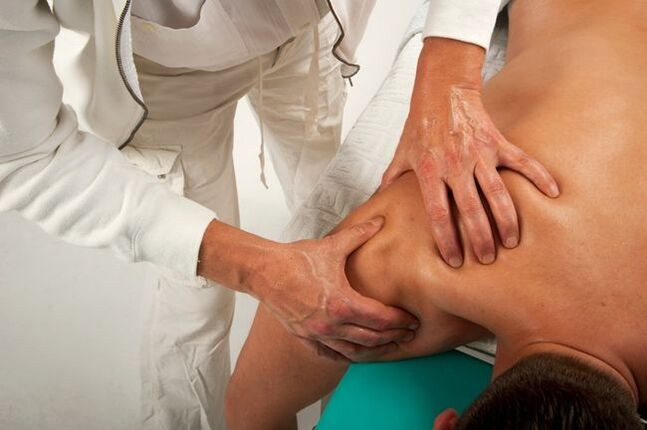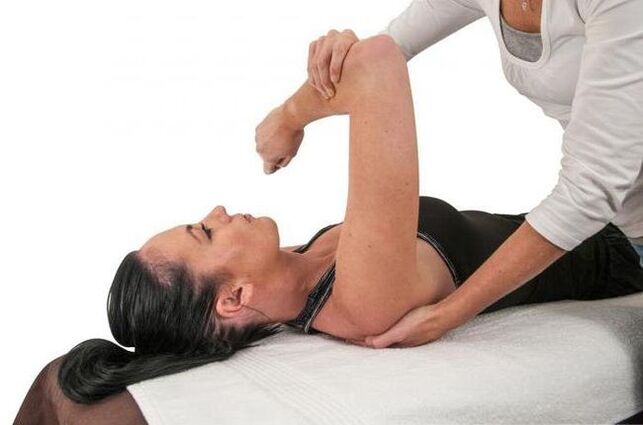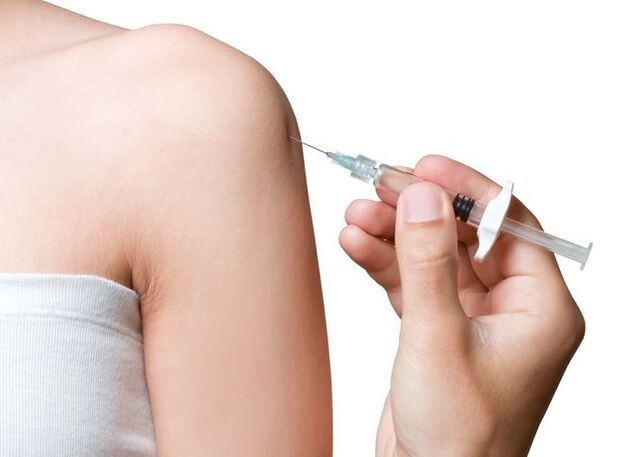Our joints experience constant stress throughout our lives. As a result, the cartilage tissue wears out, the bone tissue becomes deformed, and osteoarthritis of the shoulder joint appears, which has become one of the most common problems among elderly and elderly people.
The development of the disease can lead to complete limitation of movements and constant pain in the joints. Therefore, treatment of osteoarthritis should begin at the first manifestations of the disease.
What is osteoarthritis of the shoulder joint
Dystrophic changes in the cartilage and adjacent bone tissue of the shoulder joint are defined in medicine as osteoarthritis of the shoulder joint ICD-10 - M19. 91. Most often, osteoarthritis occurs in the acromioclavicular joint of the shoulder, which most often experiences constant stress and severe stress during the day.
Under the influence of injuries and various inflammatory processes, cartilage tissue is damaged and gradually weakens, becoming fragile and thin. Cracks are formed in the cartilage, in which salts begin to be deposited, accelerating the destructive processes of cartilage tissues. As a result of such salt deposits, bone tissue becomes dense and begins to deform, acromioclavicular osteoarthritis develops.

This process occurs slowly and is chronic; at first it is asymptomatic, but gradually the manifestations of the disease become more pronounced and can lead, over time, to complete immobility of the joint area.
The following factors can trigger the onset of the pathological process:
- Shoulder injuries that have caused deformity of the joint and caused inflammation.
- Insufficient blood supply to the shoulder joint, which lasts for a long time - this condition can be caused by vascular disorders.
- Constant and high loads on the joints are observed in construction workers, athletes and loaders.
- Congenital joint pathologies.
- Poor diet and, as a result, metabolic disorders.
Important!The most common form of the disease is post-traumatic osteoarthritis of the shoulder joint, ICD-10 code -M19. 91.
The shoulder joint is one of the most mobile in humans, which causes fairly frequent injuries to the joint. Even a small injury to a joint, repeated regularly and over a long period, leads to the development of osteoarthritis. Osteoarthritis of the right shoulder joint is the most common, because the majority of the population is "right-handed" and the load on the right side is always higher.
Causes and factors for the development of the disease
Most often, osteoarthritis is diagnosed in older people, and the older the person, the greater the likelihood that pathology will be detected.
Causes and prerequisites for the development of shoulder osteoarthritis:
- Injuries. Fractures, bruises and dislocations affect the bone and cartilaginous tissue of the shoulder joint, causing various complications - damage to the capsule, rupture of ligaments. Prompt treatment prevents the development of complications and the appearance of osteoarthritis.
- Vascular pathologies. Diabetes mellitus, atherosclerosis and varicose veins can affect the development of osteoarthritis. In addition, the risk of contracting the disease is increased in people who abuse tobacco.
- Physical inactivity. Lack of physical activity, combined with excessive eating, leads to extra pounds. As a result, metabolism is disrupted, which leads to impaired blood circulation in the cartilage and periarticular tissues - osteoarthritis develops.
- Hormonal and immune disorders- gout, psoriasis, etc.
- Joint diseases– synovitis, chronic and acute arthritis, aseptic tissue necrosis.
- Diseases of the endocrine system and metabolic disorders. These conditions cause the body to be deficient in vitamins and minerals needed for joint health (such as calcium and phosphorus). This negatively affects the condition of the joints and complicates recovery processes.
Most often, osteoarthritis does not occur under the influence of a single factor, its development is promoted by a combination of several causes simultaneously.
Types and symptoms of shoulder osteoarthritis
Since the development of osteoarthritis continues for a long time, the disease may at first practically not manifest itself, sometimes making itself felt after severe physical overload or hypothermia.

The main symptoms of osteoarthritis:
- Shoulder pain.This is the main sign of osteoarthritis - the pain is of a different nature, usually intensifies with movement and with load on the shoulder joint. The pain causes discomfort that limits shoulder mobility.
- Crackling noise when moving. Salt deposits in the shoulder joints cause a characteristic cracking (or clicking) sound in the joint during movement.
- Movement restrictions. This manifests itself depending on the stage of osteoarthritis - at the beginning of the disease there are no restrictions, during the exacerbation the patient cannot freely turn and move the arm.
Sometimes the location of the pain can be atypical and hurt in the arm or elbow. By palpation, you can determine the main sources of pain - the lower edge of the scapula and clavicle.
Note!At the initial stage, 1st degree osteoarthritis does not cause any symptoms. This is due to the lack of nerve endings in the cartilage tissue, as a result of which the disease begins to manifest itself when the pathological process extends far beyond the joints..
Depending on the nature and extent of damage to bone and cartilage tissues, there are three stages of osteoarthritis, characterized by certain symptoms.
| Symptoms | 1st step | 2nd step | 3rd step |
|---|---|---|---|
| Pain | Occurs rarely – usually in the evening or morning, after exercise or hypothermia | Severe pain that occurs with any movement | The pain is constant, even at rest |
| Movement restrictions | Slightly | The range of possible movements is reduced | A sudden and sometimes complete limitation of mobility. Abduction of the arm and its elevation become impossible. The hand must be held in a forced position, which is very painful |
| Cracking and crunching in the shoulder joint | Slight crunching when making a sudden movement - no pain | With every movement you hear a clear crunch and crackle | Constant crunchy clicks heard with every movement |
| Local manifestations (redness and swelling of the joint area, increased temperature at the site of the disease) | Not here | Appears during periods of exacerbation | There is constant inflammation in the joint |
| Joint hardening | Not here | Rarely occurs | There is hardening and deformity of the shoulder |
| Joint changes visible on x-ray | Not here | Signs of joint deformation, narrowing of the joint space and the appearance of osteophytes are visible | Traces of joint destruction are visible |
The period of the first stage can last from several months to several years. Shoulder osteoarthritis of the 3rd degree is treated only with the help of surgical measures, sincethe condition threatens disability.
One of the types of pathology is deforming osteoarthritis of the shoulder joint. This condition means the destruction of articular cartilage, causing irreversible changes to the bones of the joint surfaces. In addition to the cartilage tissue, these changes also affect the joint capsule and the synovial membrane, which leads to the destruction and deformation of the shoulder joint.
Deforming osteoarthritis manifests itself as aching, dull pain in the shoulder joint, which intensifies when the weather changes and at night. The pathology is chronic, which does not allow it to be completely cured, but it will help relieve unpleasant symptoms and stop tissue destructive processes.
How to cure osteoarthritis of the shoulder joint
Before treating shoulder osteoarthritis, a number of diagnostic measures are carried out aimed at determining the form and stage of osteoarthritis. Among these measures, it is necessary to carry out laboratory and biochemical blood tests, which can confirm the presence of an inflammatory process in the body.

If there is suspicion of shoulder osteoarthritis, the patient is asked to carry out a number of self-diagnostic measures:
- Place your hands between your shoulder blades in a lock shape;
- Tie a belt at the back of your waist;
- Bend your elbow at shoulder level and comb the hair at the back of your head.
If the patient performs all of these activities without difficulty, there is no risk of osteoarthritis. But if performing tasks is difficult and causes pain in the clavicle and shoulder area, further research is needed - fluoroscopy and magnetic resonance imaging are used for a more accurate diagnosis.
Osteoarthritis of the 2nd degree and the first stage of the disease is treated by conservative methods, and surgical measures can be used only in the absence of results.
Conservative methods of treating osteoarthritis are carried out in combination, when treatment is carried out in several directions at once:
- Treatment with medications;
- Physiotherapy;
- Treatment with traditional methods;
- Therapeutic gymnastics and acupuncture;
- Special diet;
- Spa treatment.
Important!An important condition for the treatment of shoulder osteoarthritis is to ensure rest of the shoulder joint (this is easier to do with osteoarthritis of the left shoulder joint), and such a gentle diet should be used even after the end of treatment. therapy. If the patient continues to strain the shoulder girdle, the disease will progress, ultimately leading to surgery.
Operative measures include endoprosthetic surgery - replacement of a diseased (worn) joint with its artificial counterpart. This operation is expensive and, although it considerably improves the patient's quality of life, it has the disadvantage of having to be repeated every 10 to 15 years.
Medical treatment
Drug treatment has several directions: pain relief, relief of inflammatory processes and direct restoration of cartilage tissue.
Medicines and pills
To eliminate inflammation and pain, the following groups of drugs are used:
- Non-steroidal anti-inflammatory drugs;
- Analgesics and antispasmodics.

These medications can be prescribed orally or intramuscularly (in the form of injections). They relieve pain well and relieve inflammation, but they cannot be taken for a long time - treatment is carried out in short courses.
The destruction of cartilage tissue is treated with drugs from the group of chondroprotectors, which include the active ingredients: glucosamine, chondroitin sulfate and hyaluronic acid.
Chondroprotectors are a valuable building material for cartilage tissue, but drugs have a restorative effect only in the first two stages. The first results from the use of chondroprotectors are observed only 3 months after their use, and the general duration of treatment is about a year.
When treating osteoarthritis, it is obligatory to take dietary supplements and vitamin-mineral complexes containing substances that prevent demineralization of joint tissues.
For severe inflammatory processes, a method called "intra-articular blockade" is used. The essence of the technique is the introduction of hormonal drugs into the acromion cavity. Such injections have a powerful anti-inflammatory effect, but have many side effects and therefore cannot always be used in treatment.
Ointments
For external use, ointments applied to the skin at the shoulder joint are effectively used. Ointments for osteoarthritis have an anesthetic effect, contain anti-inflammatory substances and agents that increase blood circulation.
Important!Ointments for osteoarthritis help relieve unpleasant symptoms, but they cannot cure the disease.
The advantages of ointments over painkillers are that they have a local anesthetic effect without damaging the gastrointestinal tract. But they also have a drawback: with the intensity of the pain syndrome, they cannot always quickly relieve pain.
Physiotherapy
The main method of treating osteoarthritis in the early stages is medication. Physiotherapeutic procedures can improve the effect of taking medications, and also reduce the risk of side effects.
The following therapeutic methods are used in the treatment of osteoarthritis:
- Electrophoresis;
- Exposure to a magnetic field;
- Exposure to radiation (ultraviolet, infrared, laser);
- Ultrasound.
Physiotherapeutic activities are carried out several times a year - ongoing. The type and method of treatment is selected individually for each patient, depending on the degree of the disease, the age of the patient and other indications.
Home treatment
Treatment of osteoarthritis of the shoulder joint at home is carried out in addition to drug treatment, with the permission of the attending physician.
Gymnastics and exercise therapy
Physical therapy for osteoarthritis of the shoulder joint should be carried out only in the remission phase; during exacerbations, gymnastic exercises are contraindicated.
Exercise therapy exercises can be found on the Internet, but they all need to be agreed with your doctor.
Important! You cannot select exercises for osteoarthritis yourself, no matter what authoritative sites these procedures are described on and no matter what flattering reviews accompany them. Many of them have contraindications and can cause harm rather than benefit. Therefore, before starting exercises, you should definitely consult a doctor.
Rules for home exercises for osteoarthritis:
- Exercise therapy cannot be carried out if there are decompensated diseases of the lungs and heart, if there is a high temperature or if there are diseases in which any physical activity is contraindicated.
- Exercise should not cause pain. Otherwise, they are incorrectly chosen and can lead to complications.
- When treating osteoarthritis of the shoulder joint, gymnastics requires regularity - it must be done daily. Initially, training should take no more than 5 minutes a day, gradually increasing the duration up to 20 minutes.
- You need to do the exercises gradually - first with a quarter strength, then gradually increasing the load. The intensity of movements and their amplitude should gradually increase. The older we get and the longer the duration of a sedentary lifestyle, the slower the process of increasing intensity.
- Exercises are performed in a light, semi-relaxed state - sitting or lying down.
A number of simple exercises can be performed independently every day at any time: raising and lowering the shoulders, swinging the arm back and forth, rotating the shoulders.
Massage
It is best to perform the massage for osteoarthritis of the shoulder joint immediately after exercise therapy and gymnastics. This will help improve blood circulation in the shoulder joint and promote the restoration of cartilage tissue.
Massage can be carried out only if the acute pain subsides and the inflammatory process decreases.
During the procedure, not only the sore shoulder is massaged, but also the collar area on both sides, as well as the forearm area.
Diet
Dietary rules for osteoarthritis - elimination of factors influencing the development of the disease and metabolic disorders.

Basic principles of the diet:
- Limit sugary, starchy, fatty and salty foods.
- Reduce salt intake to a minimum.
- Reduce portion sizes, but increase the number of meals (eat in small portions, but often).
- Replace the consumption of animal fats with dairy and vegetable fats.
- Increase the amount of dairy dishes in your diet, which are sources of calcium, as well as seafood and fish (source of collagen and phosphorus).
- Include more fresh fruits and vegetables in your diet.
If you suffer from osteoarthritis, you should never be hungry - the menu should be designed in such a way as to increase the intake of nutrients without harming the body and reduce the amount of harmful foods.
ethnoscience
Doctors recommend home treatment using folk remedies as an addition to medical treatment:
- Pork fat is mixed in equal proportions with propolis. The resulting ointment is rubbed with massage movements into the shoulder joint area.
- To relieve pain, herbal baths using decoctions of chamomile, burdock and nettle are recommended.
- Oatmeal is a popular remedy for osteoarthritis. They are infused in boiling water, after which the decoction is used to make compresses for the shoulder, which are applied at night.
Folk remedies do not cause side effects and have no contraindications for use.
Prevention
Preventive measures to prevent osteoarthritis include minimizing the factors that cause the disease.
General recommendations:
- Elimination of insufficient loads on the joint associated with sports or professional activities.
- Minimize the risk of injury to the shoulder joint.
- Mandatory consultations with a therapist in case of injury or pain in the shoulder joint to minimize the risk of complications.
- Prevent the appearance of excess weight - control your diet and engage in daily physical activity (gymnastics, walking, swimming).
- In old age, use drugs that promote the regeneration of cartilage and bone tissue.
Osteoarthritis of the shoulder joint is a dangerous disease that can lead to complete immobility of the joint and disability. You should consult a doctor at the first signs of illness. Treatment of osteoarthritis should be comprehensive and include conservative and alternative therapeutic methods.























